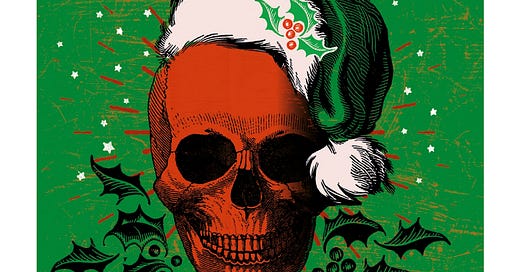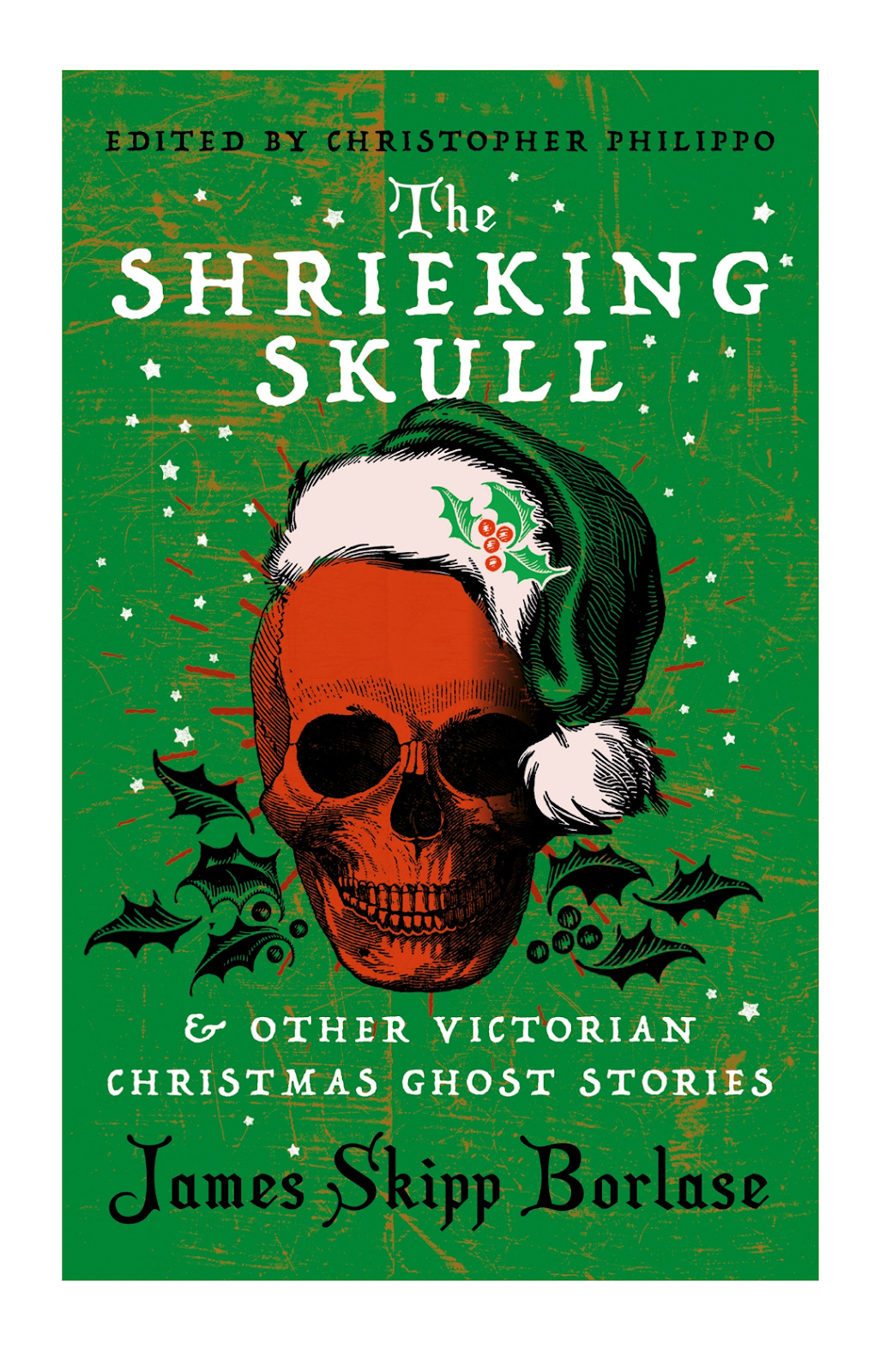The Shrieking Skull & Other Victorian Christmas Ghost Stories (2022) by James Skipp Borlase (1839–1909)
Some varieties of spectral Yuletide
Readers unfamiliar with The Shrieking Skull & Other Victorian Christmas Ghost Stories may prefer to read these notes only after reading the collection.
Most of the stories in The Shrieking Skull & Other Victorian Christmas Ghost Stories, written in the period 1866-1907, take place in the seventeenth and eighteenth centuries. A few modern items, like the enthralling "Twelve Miles Broad" (1885), seem contemporary with their period of composition. Most, however, are set during various English civil wars. There is also a horrifying continental diversion.
Each of the thirteen stories takes place before twelfth night. Most take place on Christmas Eve.
James Skipp Borlase doles-out unrest cures aplenty. His authorial voice recalls the kaleidoscopes of Washington Irving, Gogol, and Barham's Ingoldsby Legends. Family political and financial misfortunes motivate most of the action. Other clans rise and fall based on curses, duels, and unfortunate births and deaths. A woman is accused of witchcraft by a jealous friend and is threatened with bonfire execution. Orphans are saved despite predictions of talking owls and cursed riders on coal-black horses.
Urban laborers, disabled after giving faithful service to employers, are saved by efforts of gallant fiancées who brave specters to secure buried treasure. Dreams foreshadow meetings with bloody highway marauders in foreign lands. Brigands are brought to book. Scales of in-justice are weighed in Australia, Yorkshire, and the German principalities as they existed pre-1870.
Borlase's style is efficient, contagiously mirthful, and tightly focused. Ironies pockmark the pages: fortunes are reversed and re-reversed.
Chapter subtitles entice readers to stay up late to keep reading: "WHAT THE SNOW CONCEALED” and “IN WHICH NINE YEARS PASS AWAY” are two of my favorites.
💀
Varieties of spectral Yuletide: Story notes
“The Weird Wooing; or, The Ghost-Guarded Treasure: A Tale of an Old-Time Christmas and New Year's Day” (1898) is a thrilling supernatural horror story. Ivor Oliphant, a young Scot, penniless after joining the losing side in the Civil War of 1745-46, lays out a plan for instant wealth to his one time betrothed, the intensely selfish Muriel Drummond (called by her female friends – amongst themselves – “the leopard.”)
“Not the road, Ivor! Oh, not the road!” exclaimed the fair girl, with a shudder, “for, though it is a gallant calling enough, and followed nowadays by many young men of good family; nor is there, that I can see, any lack of honour in pursuing such a career so long as blackmail is only levied upon whigs and such like, yet the highway so often leads to the gibbet, that——”
“I was not thinking of adopting the profession of a highwayman, fashionable though it has become,” exclaimed Oliphant, laughingly interrupting her.
“No,” he added, suddenly becoming grave again, “but there is an old building in Edinburgh which is supposed to be crammed with wealth, belonging now to no one, and yet which it would require a bold and even well-nigh desperate man to appropriate, for the house I speak of has been closed, barred, bolted, locked and sealed for more than a hundred years, and the Plague lies buried therein.”
“Bride From the Dead: Tale of a Dreadful Christmas Wedding” (1899) takes place during a near-apocalyptic Christmas Eve snowstorm in Cumberland during the reign of Charles II. Two friends are reunited at an inn called The Saracen’s Head.
“What the deuce prompted you to ask me to meet you here, at a village inn, instead of seeking me at my own house, under Grisdale pike, where you would have been so heartily welcomed?” asked Dacre.
“Because I stood in too immediate a need of your services, and my going to Grisdale Pike, instead of your coming here, would have meant the loss of half a dozen, in all probability, precious hours. Dacre, I want you to venture with me into what may prove to be a veritable hornet’s nest; and if the snow, which has already commenced, should happen to be a heavy fall, we shall arrive at our journey’s end none too soon, though we leave here in an hour’s time, for our destination is Murgur Dale, and our route will lie between the Saddleback Mountain and the Souther Fell.”
“And what may be the object to be gained by our traversing in such weather as the present as abominable and perilous a track of country as any in all Cumberland, or, for that matter, in all England?” asked Dacre.
“To stop as infamous a marriage as a scoundrel and a coward ever concocted between them.”
“Who is the scoundrel, who is the coward, and, above all, who the fair damsel who is apparently to be sacrificed between them; for it is very evident to me that your interest is centred in the bride rather than the bridegroom?”
“Why, that old roué and reprobate, Sir Archibald Dutton, of The Howk, is about to force Sir Ralph Oughterby, of Caldbeck Hall, to give his only daughter, my own affianced bride, and the loveliest girl in all Cumberland, to wife, under the threat that in case of refusal he will denounce him to the Government as having been deeply involved, the year before last, in the cause of the young pretender; and, furthermore, that he will bring his two sons to the gallows at Carlisle for more than one act of robbery upon the King’s highway, of all which crimes and misdemeanours he asserts that he holds the most damning proofs; wherefore he is the scoundrel and Oughterby the coward I take it.”
The action and gallantry are well-crafted, and recall the vigorous “tales of long ago” by authors as varied as Conan Doyle, Robert Louis Stevenson, Margery Bowen, and Dennis Wheatley.
“The Shrieking Skull; or, Haunted Wardley Hall” (1901) takes place on two consecutive Christmas Eves. Like the more charming “Tale of Two Christmases,” it concerns a member of the Osbaldistan clan: a near-destitute young cavalier of the year 1650, and his troubled wooing of Roundhead beauty Ruth Brierley. The skull has the final say.
“The Black Cat; or, The Witch-Branks of Loughborough: A Story of Two Leicestershire Christmas Eves” (1881) explores jealousy between two women, and how witch-hunting circa 1634 was used by one to thwart the other. It's a wonderfully creative use of lore and tradition to support melodrama. Not to be missed.
Wild, isolated winter landscapes are rarely evoked with the authority employed by Borlase in “Two Ghostly Swordsmen; or, The Duel on the Moor” (1905). In this backdrop, young Sir Haigh Rowley meets Mr. Cornelius Crooks to duel for the hand of Maggie Mortimer. After a careful account of the run-up to the duel, Borlase executes a slingshot ending covering the double-edged wealth and comfort enjoyed by Maggie Crooks until the end of her tenancy in the pleasure dome constructed by her husband.
“The Fiery Skull: A Tale of Magic and Spiritualism” (1866) is a story old as time for readers of horror fiction. Two young male friends, curious about the Black Arts (as young male friends often are), employ an immigrant Italian necromancer as their tutor. Alas, he is accompanied by a beautiful daughter. Will a duello result? If you've read this far in Borlase, the answer is obvious.
“Twelve Miles Broad” (1885) is a powerful rural adventure story with uncanny undertones. It is set in rural Australia. Before a winery owner and his daughter sit down to Christmas lunch with her fiance, they are interrupted by a passing tramp. He asks for a place at their table. Is this one of the fabled angels sent down to earth on holidays to find worthy persons? (See my note on Jeffrey Ford's story “The Visitation” in Christmas and Other Horrors here). When the request is rejected, calamity results.
“The Haunted Silk Mill; or, The Ghost-Guarded Treasure” (1905) is an active, adventuring story with a modern setting. Silk mill sewer Jane Morgan dares the specters of her factory on Christmas Eve to ensure a future for herself and her man, Joe Need. When she finally meets the factory's original begetter, John Lombe, the spectral intercourse takes an unexpected turn.
“The Steel-Bound Valise, or, The Murder at the Old Stone Cross” (1875) takes place in continental Europe in the year 18--. Our narrator is on a diplomatic messenger trip. Falling asleep in his coach, he watches helplessly as a fellow passenger is slaughtered by a husband and wife who run a l'auberge rouge. Waking, he watches in horror as the coach arrives at the dream's location. It's a shocking and bloody story, which is a compliment.
“Bored to Death” (1875) is a reminiscence of Mr. Polhammer, our narrator: a “poor-devil author.” He makes the acquaintance of a fellow ink-stained wretch, another attic-dweller at Mrs. McScrewsby’s boarding house: Mr. Jones of room eight. Jones tells Mr. Polhammer about the success of his revenge plot against an editor who cut him: Archibald Pippin, Esq. of Bullion's Monthly. It's all good murderous fun, but too cold-blooded for Mr. Polhammer
“The Spectre Horseman; or, Haunted Wye-Coller Hall” (1903) covers the unhappy Christmas of 1644 for royalist Sir Roger Cunliffe. He begins the evening drinking the health of Charles I, and ends it imploring a local witch for permanent amnesia about the preceding year. If, like me, you've been curious about how a man can get the spectral horseman job, look no further.
“Our Fellow Lodger; or, The Adventures of a Christmas Eve” (1864) provides one answer to the age-old question: Did every medical student eventually come to class and find the body of his beloved on the dissection table? Fortunately, the miracle science of “Russian embalming” promises a happy ending.
“A Tale of Two Christmases” (1907) tells the story of two brothers who rescue an orphan girl during a snowstorm. They adopt her and eventually each falls in love with her. Which will she pick to be her… husband? As Borlase asks in the antepenultimate sentence: “What need is there to continue our story further.”
What indeed…
💀
The Shrieking Skull & Other Victorian Christmas Ghost Stories is an exciting collection of stories. The industry displayed by James Skipp Borlase over nearly four decades of professional writing is humbling. Articles covering his career can be read here and here.
Jay
15 December 2023




